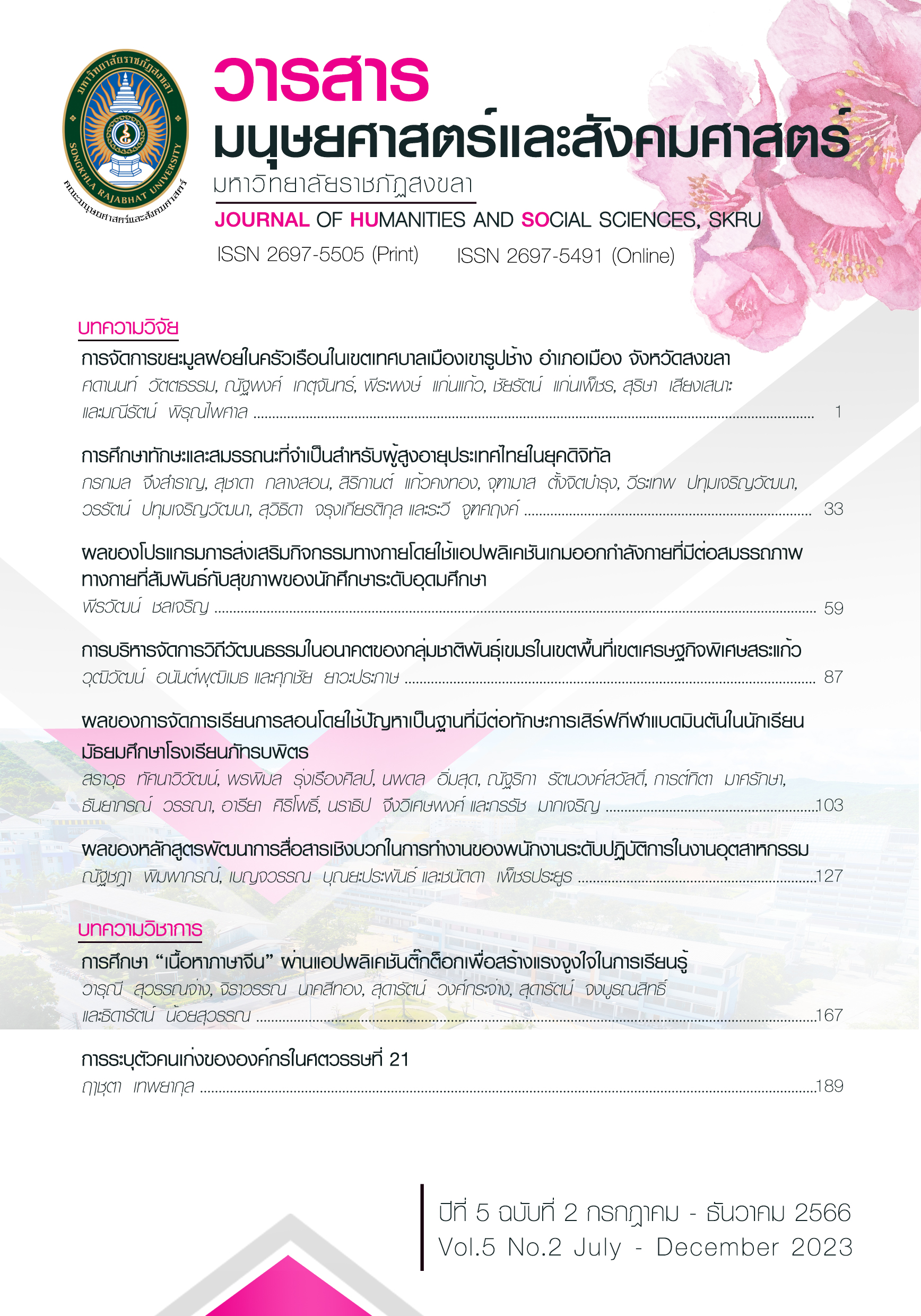THE STUDY OF “CHINESE LANGUAGE CONTENT” THROUGH TIKTOK APPLICATION TO MOTIVATE LEARNING
Main Article Content
Abstract
In the New Normal era, learners have been more adapted in online learning. The TikTok application is one of the applications that is getting a lot of interest at the moment. Apart from being a modern platform, convenient to use, and easy to access in a limited time of today's society, most people use this application for entertainment, making income, education, keeping track of news, adding friends or finding a partner, creating a profile, etc.
In terms of education, this application provides more interesting learning approach than those of typical online learning. Especially, people interested in the Chinese language are able to choose education services, acquire knowledge in a variety of ways such as pronunciation of Chinese Phonetic Alphabet, vocabulary, phrases, sentences, translations, grammar principles, Chinese Proficiency Test (HSK), Chinese alphabet memorization techniques, Chinese quotes, idioms and proverbs, discussion on various topics, Chinese art and culture, Chinese singing, Chinese dancing, Chinese series, etc. Leaners are able to learn that knowledge via TikTok without any costs just follow the person who provides Chinese knowledge in that form. If it is a teaching format that takes a long time to lecture on some contents, educators will broadcast live at convenient times in order to give learners the opportunity to get to know each other better and be able to immediately exchange or ask questions during that time. Moreover, it can also be shared with friends to join in listening to the live lecture which can be considered as increasing the number of followers as well.
The author realizes the importance of using TikTok application in order to create learning motivation, build up new knowledge and be able to apply it in teaching and learning Chinese language which makes the teaching atmosphere fun, interesting and encourages students’ good attitude. it is also another way to build relationships with Chinese people or Chinese language teachers, both domestic and foreign countries (China, Taiwan), which increases the opportunity of using Chinese to communicate in order to upgrade Chinese language skills, share knowledge, understand the differences between Thai and Chinese cultures.
Downloads
Article Details

This work is licensed under a Creative Commons Attribution-NonCommercial-NoDerivatives 4.0 International License.
ลิขสิทธิ
References
เกสริน ขันธจีรวัฒน์. (2563). การศึกษาปัจจัย พฤติกรรม และความพึงพอใจของผู้ใช้แอปพลิเคชัน Tiktok ชาวไทยและจีน. [สารนิพนธ์ปริญญาอักษรศาสตรบัณฑิต]. สาขาวิชาเอเชียศึกษา คณะอักษรศาสตร์ มหาวิทยาลัยศิลปากร.
คุณาพร มีเจริญ. (2563). การพัฒนาความสามารถในการฟัง-พูดภาษาจีน ด้วยการจัดการเรียนรู้ที่เน้นภาระงานร่วมกับสื่อมัลติมีเดีย สำหรับนักเรียนชั้นมัธยมศึกษาปีที่ 1. [วิทยานิพนธ์ปริญญามหาบัณฑิต]. บัณฑิตวิทยาลัย มหาวิทยาลัยศิลปากร.
จิรารัตน์ ประยูรวงษ์. (2562). การเรียนรู้ภาษาอังกฤษบนโลกดิจิทัลในศตวรรษที่ 21. บัณฑิตศึกษามหาวิทยาลัยราชภัฏวไลยอลงกรณ์ในพระบรมราชูปถัมภ์. 13(1), 210-223.
ณัฏฐพงษ์ สายพิณ. (2563). ปรากฏการณ์ทางวัฒนธรรมวิชวลผ่าน Tiktok ในสังคมไทย. สาร สื่อ ศิลป์มหาวิทยาลัยแม่โจ้. 3(5), 55-66.
ปิยนุช จึงสมานุกูล. (2563). องค์ประกอบของแอปพลิเคชั่น TikTok ที่ทำให้เกิดแรงกระตุ้นในการซื้อสินค้าของกลุ่มเจเนอเรชั่นซีในประเทศไทย. [สารนิพนธ์ปริญญาการจัดการมหาบัณฑิต]. วิทยาลัยการจัดการ มหาวิทยาลัยมหิดล.
ยุพดี หวลอารมณ์,จิดาภา อมรางกูร และวัชราภรณ์ เจริญสะอาด. (2564). การจัดการเรียนการสอนภาษาจีนผ่านแอปพลิเคชันสื่อสังคมออนไลน์เพื่อสร้างเเรงจูงใจในการเรียนรู้. มนุษยศาสตร์และสังคมศาสตร์มหาวิทยาลัยราชภัฏอุดรธานี. 10(1), 37-52.
รณิดา อัจกลับ. (2562). ความพึงพอใจและพฤติกรรมการมีส่วนร่วม Challenge ในแอปพลิเคชัน TikTok ของผู้ใช้ที่อาศัยในเขตกรุงเทพมหานคร [วิทยานิพนธ์ปริญญามหาบัณฑิต]. บัณฑิตวิทยาลัย มหาวิทยาลัยกรุงเทพ.
วรรณรัตน์ มหาธาราทอง. (2564). การศึกษาแนวทางการจัดการเรียนการสอนภาษาจีนในยุค Next Normal. วิทยาการจัดการปริทัศน์ คณะมนุษยศาสตร์และสังคมศาสตร์ มหาวิทยาลัยราชภัฏพระนครศรีอยุธยา. 23(2), 189-195.
สหรัฐ ลักษณะสุต. (2565). ผลการใช้แอปพลิเคชัน TikTok เพื่อพัฒนาทักษะการพูดภาษาอังกฤษของผู้เรียนภาษาอังกฤษในฐานะภาษาต่างประเทศระดับมัธยมศึกษาตอนปลาย ท่ามกลางสถานการณ์การแพร่ระบาดของโรคติดเชื้อไวรัสโคโรนา 2019. นวัตกรรมการเรียนรู้และเทคโนโลยี คณะครุศาสตร์อุตสาหกรรมและเทคโนโลยี มหาวิทยาลัยเทคโนโลยีพระจอมเกล้าธนบุรี. 2(1), 61-71.
สิตานันท์ แขวงเมือง. (2563). เปรียบเทียบพฤติกรรมของการใช้แอพพลิเคชัน TikTok ของคนไทยและรัสเซีย [ภาคนิพนธ์ ศิลปศาสตรบัณฑิต]. คณะศิลปศาสตร์ มหาวิทยาลัยธรรมศาสตร์.
สุชานันท์ อารีราษฎร, ภิญญดา อินทนิล, เกตุวดี สมบูรณ์ทวี และกนกวรรณ กิจชระภูมิ. (2561). อิทธิพลของการยอมรับเทคโนโลยีต่อการเลือกใช้แอพพลิเคชั่นติ๊กต๊อกของผู้ใช้งาน. ใน จรัญ มงคลวัย และชำนาญวิทย์ พรมโคตร (บ.ก.). นวัตกรรมสร้างสรรค์สังคมอย่างยั่งยืน. รายงานสืบเนื่องการประชุมวิชาการราชมงคลสกลนคร ครั้งที่ 1. (น.E196-203). มหาวิทยาลัยเทคโนโลยีราชมงคลอีสาน วิทยาเขตสกลนคร.
เสกสรร สายสีสด, ณัฐวุฒิ คำทวี, ธิฆัมภรณ์ แกล้วกล้า, วราภรณ์ โพนแป๊ะ, เอกรัตน์ แซ่อึ้ง และภัคจิรา ทองนิล. (2564). การศึกษาพฤติกรรมการใช้และความพึงพอใจในการใช้แอปพลิเคชัน TikTok ของนักเรียน นักศึกษาในเขตเทศบาลนครอุดรธานี. วิทยาการจัดการมหาวิทยาลัยราชภัฏอุดรธานี. 2(3), 11-26.


